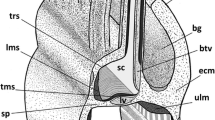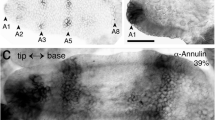Abstract
The house shrew embryo has many cells in the ventricular lumen and on the luminal surface of the fusing terminal lip of the cephalic neural tube. The origin and fate of these cells were studied by means of light and electron microscopy, and by DiI labeling in a whole-embryo culture system. The cells appeared at stage 11A and persisted until stage 12A. Most of the cells seemed to originate from the neuroepithelium, as shown by frequent observations of epithelial cell escape and DiI labeling analysis. The cells on the luminal surface sometimes showed apoptotic features, but were not subjected to phagocytosis. Some of the escaping cells seemed to migrate to the ventral part of the prosencephalic neuropore and insert themselves into it. Others separated from the luminal surface and floated into the lumen. It seems likely that the floating cells either become autolyzed, or else change into macrophage-like cells, the latter alternative being supported by the results of DiI labeling. The macrophage-like cells actively phagocytosed the other degenerating cells and apoptotic bodies. These observations suggest that the apical escape of cells may play an important role in the remodeling of the neural fold during the terminal lip fusion, and that early neuroepitheial cells may have the potential to become cells with vigorous phagocytic activity, like macrophages.
Similar content being viewed by others
References
Bancroft M, Bellairs R (1975) Differentiation of the neural plate and neural tube in the young chick embryo. Anat Embryol 147:309–335
Cline MJ, Moore MAS (1972) Embryonic origin of the mouse macrophage. Blood 39:842–849
Ernst M (1926) Über Untergang von Zellen während der normalen Entwicklung bei Wirbeltieren. Z Anat Entwicklungsgesch 79:228–262
Freeman B (1972) Surface modifications of neural epithelial cells during formation of the neural tube in the rat embryo. J Embryol Exp Morphol 28:437–448
Gaare JD (1976) Cell degeneration during the fusion of the nasal processes in mice (abstract). Anat Rec 184:407
Geelen JAG, Langman J (1977) Closure of the neural tube in the cephalic region of the mouse embryo. Anat Rec 189:625–640
Geelen JAG, Langman J (1979) Ultrastructural observations on closure of the neural tube in the mouse. Anat Embryol 156:73–88
Glücksmann A (1951) Cell deaths in normal vertebrate ontogeny. Biol Rev 26:59–86
Hayward AF (1969) Ultrastructural changes in the epithelium during fusion of the palatal processes in rats. Arch Oral Biol 14:661–678
Heidekruger R, Merker HJ (1972) Elektronenmikroskopische Untersuchung der Linsenentwicklung bei Rattenembryonen. Z Anat Entwicklungsgesch 136:115–124
Kerr JFR, Wyllie AH, Currie AR (1972) Apoptosis: a basic biological phenomenon with wide-ranging implications in tissue kinetics. Br J Cancer 26:239–257
Kosaka K, Hama K, Eto K (1985) Light and electron microscopic study of fusion of facial prominences. Anat Embryol 173:187–201
Martín-Partido G, Navascuíés J (1990) Macrophage-like cells in the presumptive optic pathways in the floor of the diencephalon of the chick embryo. J Neurocytol 19:820–832
Morriss-Kay GM (1981) Growth and development of pattern in the cranial neural epithelium of rat embryos during neurulation. J Embryol Exp Morphol 65 [Suppl]:225–241
Nichols DH (1986) Mesenchyme formation from the trigeminal placodes of the mouse embryo. Am J Anat 176:19–31
Oda S (1985) Management, keeping and breeding. In: Kondo K (ed) Suncus murinus. Japan Scientific Societies Press, Tokyo, pp 102–111
Oppenheim RW (1991) Cell death during development of the nervous system. Annu Rev Neurosci 14:453–501
O'Rahilly R, Müller F (1989) Bidirectional closure of the rostral neuropore in the human embryo. Am J Anat 184:259–268
Osumi-Yamashita N, Asada S, Eto K (1992) Distribution of Factin during mouse facial morphogenesis and perturbation with cytochalasin D using whole-embryo culture. J Craniofac Genet Dev Biol 12:130–140
Penfold PL, Provis JM (1986) Cell death in the development of the human retina: phagocytosis of pyknotic and apoptotic bodies by retinal cells. Graefes Arch Clin Exp Ophthalmol 224:549–553
Sakai Y (1989) Neurulation in the mouse: manner and timing of neural tube closure. Anat Rec 223:194–203
Schlüter G (1973) Ultrastructural observations on cell necrosis during formation of the neural tube in mouse embryos. Z Anat Entwicklungsgesch 141:251–264
Selleck MAJ, Stern CD (1991) Fate mapping and cell lineage analysis of Hensen's node in the chick embryo. Development 112:615–626
Webster DA, Gross J (1970) Studies on possible mechanisms of programmed cell death in the chick embryo. Dev Biol 22:157–184
Yasui K (1992) Embryonic development of the house shrew (Suncus murinus). I. Embryos at stages 9 and 10 with 1 to 12 pairs of somites. Anat Embryol 186:49–65
Yasui K (1993) Embryonic development of the house shrew (Suncus murinus). II. Embryos at stages 11 and 12 with 13 to 29 pairs of somites, showing limb bud formation and closed cephalic neural tube. Anat Embryol 187:45–65
Author information
Authors and Affiliations
Rights and permissions
About this article
Cite this article
Yasui, K., Ninomiya, Y., Osumi-Yamashita, N. et al. Apical cell escape from the neuroepithelium and cell transformation during terminal lip fusion in the house shrew embryo. Anat Embryol 189, 463–473 (1994). https://doi.org/10.1007/BF00186821
Accepted:
Issue Date:
DOI: https://doi.org/10.1007/BF00186821




